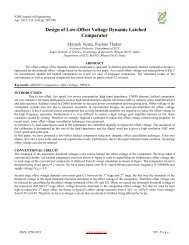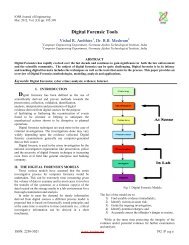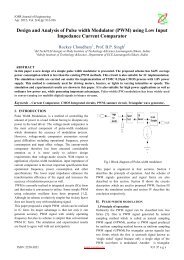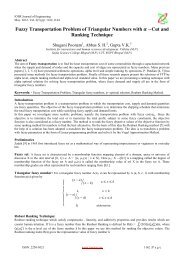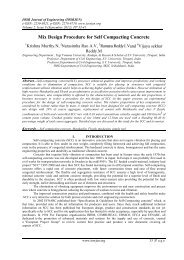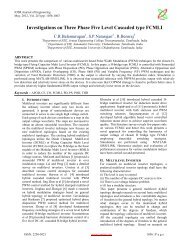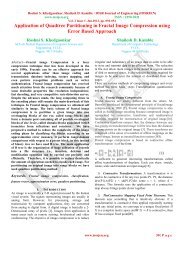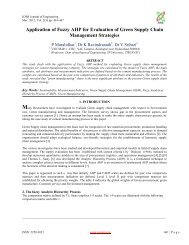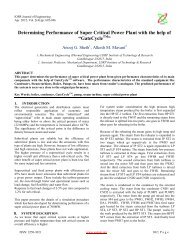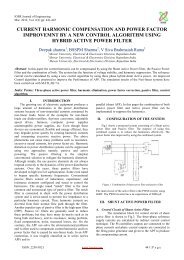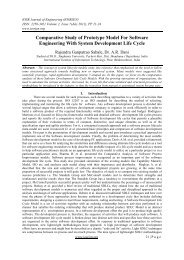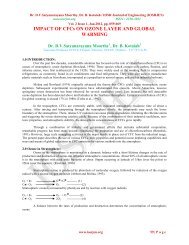The Inter-relationship of Bulk Density and Porosity of ... - IOSRJEN
The Inter-relationship of Bulk Density and Porosity of ... - IOSRJEN
The Inter-relationship of Bulk Density and Porosity of ... - IOSRJEN
You also want an ePaper? Increase the reach of your titles
YUMPU automatically turns print PDFs into web optimized ePapers that Google loves.
IOSR Journal <strong>of</strong> Engineering<br />
Apr. 2012, Vol. 2(4) pp: 555-562<br />
<strong>The</strong> <strong>Inter</strong>-<strong>relationship</strong> <strong>of</strong> <strong>Bulk</strong> <strong>Density</strong> <strong>and</strong> <strong>Porosity</strong> <strong>of</strong> Some Crystalline<br />
Basement Complex Rocks: A Case Study <strong>of</strong> Some Rock Types In<br />
Southwestern Nigeria.<br />
Ademeso, Odunyemi Anthony<br />
Department <strong>of</strong> Geology, Adekunle Ajasin University, Akungba-Akoko, Nigeria.<br />
Adekoya, John Adeyinka<br />
Department <strong>of</strong> Applied Geology, <strong>The</strong> Federal University <strong>of</strong> Technology, Akure, Nigeria.<br />
Olaleye, Boluwaji Muraina<br />
Department <strong>of</strong> Mining Engineering, <strong>The</strong> Federal University <strong>of</strong> Technology, Akure, Nigeria.<br />
ABSTRACT<br />
<strong>The</strong> inter-<strong>relationship</strong> <strong>of</strong> bulk density <strong>and</strong> porosity <strong>of</strong> some crystalline rocks in southwestern Nigeria was<br />
investigated. Six crystalline basement complex rock types from two localities in Nigeria (three each from Akure <strong>and</strong> Igarra)<br />
were sampled <strong>and</strong> tested for their petrography (mineralogy, texture <strong>and</strong> microstructures), bulk density <strong>and</strong> porosity. ImageJ<br />
was used for image analysis <strong>of</strong> the photo-micrographs, the bulk density was calculated from the determined specific gravity<br />
while the porosity was determined by water saturation technique. From the results <strong>of</strong> the analyses, the rocks were found to<br />
contain quartz, feldspar, hornblende, mica <strong>and</strong> minor minerals in various proportions. Micro-structures such as bent twin<br />
lamellae, undulose extinctions, distorted <strong>and</strong> incomplete twining <strong>and</strong> platy mineral alignment were observed in the thin<br />
sections <strong>of</strong> the rocks. <strong>The</strong> bulk density values ranged from 2.63 to 2.81 <strong>and</strong> the porosity from 0.03 to 0.16. <strong>The</strong> correlation<br />
coefficient relating the two parameters is -0.9713 indicating a very high negative correlation. <strong>The</strong> square <strong>of</strong> Pearson Product<br />
moment correlation coefficient is 0.9434. A mathematical model was derived from the <strong>relationship</strong> between the two<br />
parameters. <strong>The</strong> st<strong>and</strong>ard error <strong>of</strong> 0.02 <strong>and</strong> the Ftest <strong>of</strong> 0.98 were determined for the model. It was deduced that the porosity<br />
<strong>of</strong> a crystalline rock is affected mainly by its bulk density <strong>and</strong> possibly by the degree <strong>of</strong> weathering.<br />
Keywords: bulk density, correlation coefficient, micro-structures, porosity, <strong>relationship</strong><br />
1. INTRODUCTION<br />
<strong>The</strong> anisotropic nature <strong>of</strong> rocks is believed to be caused by variations in their petrography (mineralogy, texture <strong>and</strong><br />
micro-structures) <strong>and</strong> physical properties. <strong>The</strong>se variations have been discovered to occur even in locations which are only a<br />
few centimetres apart on an outcrop. As a result <strong>of</strong> this, similar rock types in the same locality may not yield the same<br />
engineering properties <strong>and</strong> therefore may not be suitable for the same use. This explains why confirmatory tests on rocks<br />
require lots <strong>of</strong> test samples <strong>and</strong> are therefore very expensive, time consuming <strong>and</strong> tedious (Teme, 1983). <strong>Bulk</strong> density <strong>and</strong><br />
porosity are two <strong>of</strong> the physical properties that have been found to significantly affect the mechanical properties, particularly<br />
Uniaxial Compressive Strength (UCS), <strong>of</strong> crystalline rocks. Slight variations in these parameters, particularly porosity, have<br />
been discovered to correspond to significant variations in UCS (Ademeso, 2011). <strong>Porosity</strong> <strong>of</strong> a crystalline rock is the sum <strong>of</strong><br />
micro-fractures, intra-granular pores <strong>and</strong> fluid inclusions (Tullborg <strong>and</strong> Larson, 2006). Generally, crystalline rocks are<br />
believed to exhibit extremely low porosity values (as low as < 1%) because intra-granular pores <strong>and</strong> fluid inclusions are rare<br />
occurrences in them.<br />
Researchers usually take porosity <strong>of</strong> crystalline rocks for granted, by not testing for it, perhaps as a result <strong>of</strong> its<br />
extremely low values whereas a slight variation in this parameter can lead to significant variation in UCS which can cause<br />
serious disruption <strong>of</strong> engineering designs. <strong>The</strong> establishment <strong>of</strong> a <strong>relationship</strong> between the two important parameters <strong>of</strong> bulk<br />
density <strong>and</strong> porosity will, however, provide a way out <strong>of</strong> the possible impasse. This can also lead to a reduction in the cost<br />
<strong>and</strong> time required to test for them during reconnaissance surveys as the bulk density (which is an essential test parameter) can<br />
be used to estimate the porosity <strong>of</strong> the rock. Furthermore, such estimations make it possible to identify areas that require<br />
further survey, as well as to demarcate those that could possibly cause a future failure <strong>of</strong> engineering structures.<br />
<strong>The</strong> two study areas (Akure <strong>and</strong> Igarra) for this project, where six rock types have been selected as case study, are<br />
located within the Basement Complex <strong>of</strong> South-western Nigeria (Fig.1). <strong>The</strong> rocks <strong>of</strong> this complex have been variously<br />
classified by Rahaman (1976, 1988); Odeyemi (1988); Adekoya (1996) <strong>and</strong> Adekoya et al. (2003). Adekoya et al., (2003)<br />
classified the rocks as (a) the gneiss-migmatite-quartzite complex; (b) the schist belts which are low to medium grade<br />
supracrustal <strong>and</strong> meta-igneous rocks; (c) the Pan African granitoids (Older Granites) <strong>and</strong> other related rocks such as<br />
ISSN: 2250-3021 www.iosrjen.org 555 | P a g e
IOSR Journal <strong>of</strong> Engineering<br />
Apr. 2012, Vol. 2(4) pp: 555-562<br />
charnockitic rocks <strong>and</strong> syenites; <strong>and</strong> (d) minor felsic <strong>and</strong> mafic intrusives. <strong>The</strong> major rock types exposed in the Akure area<br />
consist <strong>of</strong> the following: (i) migmatite-gneiss; (ii) medium to coarse grained biotite granite; (iii) charnockitic intrusives <strong>and</strong><br />
(iv) coarse porphyritic biotite <strong>and</strong> biotite-hornblende granites. <strong>The</strong> major rock groups exposed in Igarra study area are the<br />
metasediments <strong>and</strong> the intrusives. <strong>The</strong> Igarra metasediments consist <strong>of</strong> intercalating b<strong>and</strong>s <strong>of</strong> phyllite, calcgneiss, quartzite,<br />
<strong>and</strong> metaconglomerate which are well exposed in the northern part <strong>of</strong> the area. <strong>The</strong> b<strong>and</strong>s vary in width from about 50 to<br />
200m. <strong>The</strong> Igarra metasedimentary rocks have been intruded by igneous rocks including the Igarra older granite batholith<br />
which ranges for over 5km <strong>and</strong> is over 1000m above sea level. Occurrences <strong>of</strong> metasediments were recorded at the very top<br />
<strong>of</strong> the granite batholith. Inselbergs <strong>of</strong> older granite <strong>and</strong> syenite outcrop in the northern <strong>and</strong> southern parts <strong>of</strong> the area. <strong>The</strong><br />
minor intrusions include the lamprophyres which intruded the metasediments as dykes in various parts <strong>of</strong> the area. Other<br />
minor intrusives such as quartz, pegmatite <strong>and</strong> aplite dykes <strong>and</strong> veins, commonly with N-S orientation, occur in various rock<br />
types in the area.<br />
2. METHODOLOGY<br />
2.1 Petrographic Study<br />
Prepared thin sections were studied with petrographic microscope taking care to capture the photomicrographs <strong>of</strong><br />
pertinent characteristics.<br />
2.2 Determination <strong>of</strong> <strong>Bulk</strong> <strong>Density</strong><br />
<strong>The</strong> bulk density <strong>of</strong> the rock types was determined by first finding out the specific gravity <strong>of</strong> the samples using<br />
Archimedes principle. <strong>The</strong> specific gravity, which is dimensionless, was calculated as follows:<br />
-------------- (1)<br />
<strong>The</strong> density (g/cm 3 ) <strong>of</strong> the rocks is then calculated from the established specific gravity. Since specific gravity or<br />
relative density is the ratio <strong>of</strong> the density <strong>of</strong> the substance to the density <strong>of</strong> the reference material [in this case water<br />
(1g/cm 3 )], then<br />
Fig. 1: Geological Map <strong>of</strong> South-western Nigeria Showing Study Areas.<br />
ISSN: 2250-3021 www.iosrjen.org 556 | P a g e
IOSR Journal <strong>of</strong> Engineering<br />
Apr. 2012, Vol. 2(4) pp: 555-562<br />
2.3 Determination <strong>of</strong> <strong>Porosity</strong><br />
<strong>The</strong> sample was weighed dry, then soaked in water for twenty-four hours <strong>and</strong> re-weighed (Brown, 1981). <strong>The</strong> porosity<br />
<strong>of</strong> the sample was determined as the percentage <strong>of</strong> the ratio <strong>of</strong> the difference in the soaked <strong>and</strong> the dry weight to the dry<br />
weight as follows:<br />
-------------- (2)<br />
2.4 Determination <strong>of</strong> Mathematical Model relating <strong>Bulk</strong> <strong>Density</strong> with <strong>Porosity</strong>.<br />
A chart <strong>of</strong> the scatter diagram with regression line correlating the two parameters for the rock types was also plotted with the<br />
s<strong>of</strong>tware. <strong>The</strong> determined regression equation was thereafter used in determining the model relating the two parameters. <strong>The</strong><br />
square <strong>of</strong> Pearson product moment correlation coefficient (R 2 ) <strong>and</strong> the correlation coefficient (r) between two sets <strong>of</strong> data were<br />
determined with the aid <strong>of</strong> Micros<strong>of</strong>t Excel 2007.<br />
2.5 Test <strong>of</strong> reliability <strong>of</strong> the Model.<br />
<strong>The</strong> porosity <strong>of</strong> selected rock types from the study areas was estimated with the model using the bulk density values derived<br />
from the laboratory <strong>and</strong> the result was compared with the porosity values determined in the laboratory. <strong>The</strong> variance, st<strong>and</strong>ard<br />
deviation, st<strong>and</strong>ard error <strong>and</strong> F-test were evaluated for the two sets <strong>of</strong> values in accordance with James (1999), with the aid <strong>of</strong><br />
Micros<strong>of</strong>t Excel 2007.<br />
3.1 Petrographic study<br />
3. RESULT<br />
3.1.1 Mineralogy<br />
(i) Gneiss, Ondo road, Akure.<br />
<strong>The</strong> rock consists <strong>of</strong> the following minerals (with estimated modal content): plagioclase (36%), quartz (25%), biotite<br />
(21%), hornblende (7%), microcline (6%), hypersthene (3%), muscovite (1%), pyroxene (1%) <strong>and</strong> mymerkite (0.3%) (Table<br />
1).<br />
(ii) Granite gneiss, Igbatoro road, Akure<br />
Microscopically, quartz, biotite, plagioclase, microcline <strong>and</strong> hornblende constitute the major minerals in thin section <strong>of</strong><br />
the rock while mymerkite occurs sporadically. <strong>The</strong> modal percentages <strong>of</strong> the minerals are 29%, 23%, 21%, 19%, 8%, 4%,<br />
<strong>and</strong> 1% (Table 1). Generally, the platy minerals tend to be arranged in preferred orientation that defines the foliation <strong>of</strong> the<br />
rock (Fig. 2B).<br />
A B C1 C2<br />
Gneiss with undulose extinction in plagioclase.<br />
Bar scale is 2um.<br />
Granite gneiss showing alignment <strong>of</strong> minerals<br />
particularly mica. Bar scale is 2um.<br />
D E F<br />
Charnockitic rock showing undulose extinction,<br />
bent lamellae, micro-cracks <strong>and</strong> distorted as well<br />
as incomplete twinnings. Bar Scale 3um.<br />
Charnockitic rock showing undulose extinction,<br />
bent lamellae, micro-cracks <strong>and</strong> distorted as well<br />
as incomplete twinnings. Bar scale is 3um.<br />
Porphyritic biotite granite showing phenecryst<br />
<strong>of</strong> plagioclase. Bar scale is 2um<br />
Biotite granite with bent lamellae <strong>of</strong> mica.<br />
Bar scale is 4um<br />
Lamprophyre showing biotite phenocrysts<br />
in fine groundmass. Bar scale is 1um.<br />
Fig. 2: Photomicrographs <strong>of</strong> the rock types: A = Gneiss, B = Granite gneiss, C1, C2 = Charnockitic rock, D = Porphyritic<br />
Biotite Granite, E = Biotite Granite <strong>and</strong> F = Lamprophyre.<br />
ISSN: 2250-3021 www.iosrjen.org 557 | P a g e
IOSR Journal <strong>of</strong> Engineering<br />
Apr. 2012, Vol. 2(4) pp: 555-562<br />
(iii) Charnockitic rocks, Akure<br />
Plagioclase, biotite, quartz, hypersthene, hornblende, muscovite <strong>and</strong> orthoclase are the major minerals while opaque<br />
minerals (probably iron oxide) <strong>and</strong> zircon are the accessories identified in the thin section <strong>of</strong> the rock. <strong>The</strong> modal analysis <strong>of</strong><br />
the thin sections <strong>of</strong> the rock gives 32%, 16%, 16%, 16%, 11%, 4%, 3%, 1% <strong>and</strong> 1% respectively for the minerals (Table 1).<br />
(iv) Porphyritic Biotite Granite, Somorika Road, Igarra<br />
Biotite, plagioclase, quartz, microcline <strong>and</strong> hornblende are the major minerals in the thin section <strong>of</strong> the rock while<br />
mymerkite <strong>and</strong> zircon constitute the accessories. <strong>The</strong> modal analysis <strong>of</strong> the minerals in the thin section is 31%, 30%, 23%, 10%,<br />
4%, 3% <strong>and</strong> 1%, respectively (Table 1).<br />
(v) Biotite granite (leucocratic), Ibillo road, Igarra<br />
<strong>The</strong> occurrence <strong>of</strong> microcline, plagioclase <strong>and</strong> quartz as major minerals with biotite <strong>and</strong> hornblende as subordinate<br />
minerals is revealed from the microscopic examination <strong>of</strong> the thin sections <strong>of</strong> the rock. <strong>The</strong> modal composition <strong>of</strong> the rock is<br />
37%, 30%, 27%, 5% <strong>and</strong> 1%, respectively (Table 1).<br />
(vi) Lamprophyre, Igarra<br />
Biotite, quartz, plagioclase, hornblende, microcline <strong>and</strong> opaque minerals are the major minerals identified in the thin<br />
section <strong>of</strong> the rock while zircon is the accessory (Fig. 2F). <strong>The</strong> result <strong>of</strong> the modal analysis is 41%, 23%, 21%, 6%, 5%, 5%<br />
<strong>and</strong> 0.5%, respectively, for the minerals (Table 1).<br />
S/No<br />
Sample No<br />
Table 1: Summary <strong>of</strong> modal analyses <strong>of</strong> selected rock samples.<br />
Modal (%) Content <strong>of</strong> Minerals<br />
Qtz Pla Mic Ort Bio Hyp Mus Hnb Pyx Zir Mym Opa Total<br />
1. Gn(Ak001)<br />
25<br />
36 - 6 21 3 1 7 1 - 0.3 0.1 100.4<br />
2. Ggn(Ak002) 29 21 18 - 23 - - 8 - - 1 - 100<br />
3.<br />
Chk<br />
16 32 - 3<br />
(Ak003)<br />
16<br />
16 4 11 - 1 - 1 100<br />
4. Pgr(Ig001) 23 30 10 - 31 - - 4 - 1 4 - 100<br />
5. Gr(Ig002) 27 30 37 - 5 - - - - 1 - - -<br />
6. Lam(Ig003) 23 21 4 - 41 - - 6 - - - 5 100<br />
Note: Gn = gneiss; Ggn = granite gneiss; Chk = charnockitic rock; Pgr = porphyritic biotite granite; Lam = lamprophyre; <strong>and</strong> Gr<br />
= biotite granite.<br />
Qtz = quartz; Pla = plagioclase feldspar; Mic = microcline; Ort = orthoclase; Bio = biotite; Mus = muscovite; Hnb =<br />
hornblende; Hyp = hypersthenes; Mym = mymerkite <strong>and</strong> Opa = opaque minerals.<br />
3.1.2 Texture<br />
Generally, three <strong>of</strong> the rock types (gneiss, granite gneiss <strong>and</strong> biotite granite) exhibit medium to coarse grained texture.<br />
<strong>The</strong> grains display irregular shape with sutured margins indicating that they are strongly interlocked. <strong>The</strong> charnockitic rock is<br />
largely coarse grained while the porphyritic biotite granite displays very large crystals <strong>of</strong> feldspar in finer groundmass <strong>of</strong><br />
quartz, biotite <strong>and</strong> feldspar. <strong>The</strong> charnockitic rocks <strong>and</strong> porphyritic biotite granite possess grains with sutured boundaries.<br />
<strong>The</strong> Lamprophyre possesses coarse biotite grains in a groundmass <strong>of</strong> very fine grains <strong>of</strong> biotite, quartz, feldspar <strong>and</strong><br />
hornblende, indicating porphyritic texture.<br />
3.1.3 Microstructures<br />
(i) Gneiss<br />
<strong>The</strong> rock exhibits mineral inclusions, micro-cracks, twinning, partly deformed twinning, cleavages <strong>and</strong> undulose<br />
extinction as micro-structures (Fig. 2A).<br />
(ii) Granite gneiss<br />
<strong>The</strong> rock petrography revealed cleavage, micro-cracks, mineral inclusions, twinnings <strong>and</strong> mymerkite as the microstructures<br />
exhibited by the rock (Fig. 2B).<br />
(iii) Charnockitic rocks<br />
<strong>The</strong> charnockitic rocks exhibited the following micro-structures: cleavage, distorted cleavage, mineral inclusions, microcracks,<br />
bent twin lamellae <strong>and</strong> compressed twin plane (Fig. 2C).<br />
ISSN: 2250-3021 www.iosrjen.org 558 | P a g e
IOSR Journal <strong>of</strong> Engineering<br />
Apr. 2012, Vol. 2(4) pp: 555-562<br />
(iv) Porphyritic biotite granite<br />
<strong>The</strong> micro-structures that were observed in the thin section <strong>of</strong> the rock include: cleavages, mineral inclusions, twinnings<br />
<strong>and</strong> micro-cracks (Fig. 2D).<br />
(v) Biotite granite<br />
Micro-structures such as bent lamellae, cleavage, bent cleavage, twinning <strong>and</strong> mineral inclusions were observed in the<br />
thin sections <strong>of</strong> the rock (Fig. 2E).<br />
(vi) Lamprophyre<br />
This rock type exhibited cleavage <strong>and</strong> twinning as micro-structures in thin section (Fig. 2F).<br />
3.2 <strong>Bulk</strong> <strong>Density</strong><br />
<strong>The</strong> result <strong>of</strong> the bulk density tests is presented in Table 2 (A). <strong>The</strong> values range from 2.63 for biotite granite to 2.81g/cc<br />
for charnockitic rocks.<br />
3.3 <strong>Porosity</strong><br />
<strong>The</strong> porosity tests on the samples <strong>of</strong> the selected rock samples gave results that range from 0.03 to 0.16% for<br />
charnockitic rocks <strong>and</strong> biotite granite respectively [Table 2 (A)].<br />
3.4 Mathematical Model<br />
<strong>The</strong> Correlation coefficient (r) <strong>and</strong> the square <strong>of</strong> Pearson Product Moment Correlation coefficient (R 2 ) for the<br />
<strong>relationship</strong> between the bulk density <strong>and</strong> the porosity <strong>of</strong> the selected rock types were determined as presented in Table 2 (B).<br />
<strong>The</strong> scatter diagram with regression line correlating the two sets <strong>of</strong> values was plotted (Fig. 3). <strong>The</strong> regression equation,<br />
Y = 0.7562X + 2.1564, was calculated (Fig. 3). <strong>The</strong> R 2 (0.9434) (Fig. 3) that was calculated tallies with that <strong>of</strong> Table 2 (B).<br />
Table 2: Table <strong>of</strong> the bulk density <strong>and</strong> porosity <strong>of</strong> the rock types.<br />
(A)<br />
S/No Sample No Rock Type <strong>Density</strong> (g/cc) <strong>Porosity</strong> (%)<br />
1 Ak001 Gn 2.67 0.15<br />
2 Ak002 Ggn 2.67 0.12<br />
3 Ak003 Chk 2.81 0.03<br />
4 Ig001 Pgr 2.69 0.14<br />
5 Ig002 Gr 2.63 0.16<br />
6 Ig003 Lam 2.78 0.05<br />
(B)<br />
<strong>Density</strong> R 2 r<br />
<strong>Porosity</strong> 0.9434 -0.9713<br />
Note: Gn = gneiss, Ggn = granite gneiss, Chk = charnockitic rock, Gr = biotite granite, Pgr = porphyritic biotite granite <strong>and</strong><br />
Lam = lamprophyre.<br />
<strong>Density</strong> = bulk density <strong>of</strong> rock types <strong>and</strong> <strong>Porosity</strong> = the porosity <strong>of</strong> the rock types.<br />
R 2 = the square <strong>of</strong> Pearson product moment correlation coefficient.<br />
r = the correlation coefficients between two sets <strong>of</strong> data.<br />
ISSN: 2250-3021 www.iosrjen.org 559 | P a g e
IOSR Journal <strong>of</strong> Engineering<br />
Apr. 2012, Vol. 2(4) pp: 555-562<br />
Fig. 3: Scatter diagram with regression line correlating <strong>Porosity</strong> with <strong>Bulk</strong> <strong>Density</strong> for the rock types<br />
4. Discussion<br />
A study <strong>of</strong> the <strong>relationship</strong> between bulk density <strong>and</strong> porosity shows a very high correlation coefficient value [r = -<br />
0.9713 (Table 2(B)]. This indicates a very high negative correlation between the two parameters which implies that the<br />
higher the bulk density, the lower the porosity <strong>and</strong> vice-versa. This correlation coefficient is consistent with the discovery<br />
<strong>of</strong> Gates <strong>and</strong> West (2008) that bulk density <strong>and</strong> UCS decrease with increase in vesicularity <strong>of</strong> basalt. Since vesicularity<br />
can be considered as indication <strong>of</strong> porosity, it can therefore be said that porosity increases as bulk density decreases. Table<br />
2(A) shows that (i) charnockitic rocks <strong>and</strong> lamprophyre with very low porosity values (0.03% <strong>and</strong> 0.05%) have very high<br />
bulk density values (2.81g/cc <strong>and</strong> 2.78g/cc); (ii) biotite granite with the highest porosity value has the lowest bulk density<br />
(0.16% <strong>and</strong> 2.63g/cc); <strong>and</strong> (iii) granite gneiss, porphyritic biotite granite <strong>and</strong> gneiss with similar porosity values also<br />
exhibit similar bulk density values.<br />
Biotite granite, with the highest porosity <strong>and</strong> lowest bulk density values, shows indications <strong>of</strong> incipient weathering<br />
petrographically (Fig. 2E). Charnockitic rocks with micro-structures like micro-cracks, bent lamellae, undulose extinction<br />
<strong>and</strong> distorted/deformed twinnings (Fig. 2C) have a porosity value that is close to that <strong>of</strong> lamprophyre that does not possess<br />
such micro-structures (Fig. 2F). <strong>The</strong> two rocks possess porosity values that are lower than those <strong>of</strong> the gneiss, granite<br />
gneiss, porphyritic biotite granite <strong>and</strong> biotite granite (Fig. 2A, D, E) that have fewer micro-structures. <strong>The</strong> implication <strong>of</strong><br />
this is that microstructures do not seem to have any serious influence on porosity <strong>and</strong> bulk density <strong>of</strong> the rocks.<br />
<strong>The</strong> charnockitic rocks <strong>and</strong> lamprophyre with similar porosity values exhibit diverse mineralogical characteristics <strong>and</strong><br />
therefore it can also be deduced that mineralogy does not seem to influence porosity. In the same vein, the texture does not<br />
seem to impact on the porosity as the two rocks differ substantially in this characteristic.<br />
<strong>The</strong> characteristics that are common to the two rocks with very low porosity values are (i) bulk density <strong>and</strong> (ii)<br />
absence <strong>of</strong> signs <strong>of</strong> incipient weathering. Other rock types that possess higher porosity values have lower bulk density <strong>and</strong><br />
some <strong>of</strong> them show signs <strong>of</strong> incipient weathering.<br />
Since the correlation coefficient (r) <strong>of</strong> porosity <strong>and</strong> bulk density is very high, the model derived from the regression<br />
equation would serve to give a good estimate <strong>of</strong> one parameter if the other parameter is known.<br />
<strong>The</strong> regression equation <strong>of</strong> the <strong>relationship</strong> (Fig.3) is<br />
Y = -0.756X + 2.156 ----------------------- (3)<br />
which can be re-written as<br />
<strong>Porosity</strong> = -0.756D + 2.156 ----------------------- (4)<br />
where D is the determined bulk density.<br />
This is a mathematical model expressing the inter-<strong>relationship</strong> between the two parameters.<br />
<strong>The</strong> model was used to estimate the porosity <strong>of</strong> the rock types using the determined bulk density values. <strong>The</strong> result<br />
was compared with the determined porosity values <strong>and</strong> a test <strong>of</strong> reliability was conducted by determining the mean,<br />
variance, st<strong>and</strong>ard deviation, st<strong>and</strong>ard error <strong>and</strong> F-test for the two sets <strong>of</strong> porosity values. <strong>The</strong> results are: mean <strong>of</strong> 0.11 for<br />
the two sets <strong>of</strong> values; variance <strong>of</strong> 0.0002; st<strong>and</strong>ard deviation <strong>of</strong> 0.014; St<strong>and</strong>ard Error <strong>of</strong> 0.02; <strong>and</strong> an Ftest <strong>of</strong> 0.98 (Table<br />
3). <strong>The</strong> st<strong>and</strong>ard deviation is very small compared to the mean indicating that the data are fairly tightly packed around the<br />
ISSN: 2250-3021 www.iosrjen.org 560 | P a g e
IOSR Journal <strong>of</strong> Engineering<br />
Apr. 2012, Vol. 2(4) pp: 555-562<br />
mean. <strong>The</strong> range 0.05 – 0.17 [mean ± 4(st<strong>and</strong>ard deviation)] accommodates all estimated values except 0.03 which can be<br />
regarded as an outlier. This however does not mean that the value is wrong. <strong>The</strong> model can therefore be said to be reliable.<br />
Table 3: Relationship between the <strong>Porosity</strong> values determined in the laboratory <strong>and</strong> those estimated with the derived model<br />
using bulk density <strong>of</strong> the rock types<br />
Model: P = -0.756D + 2.156<br />
Rock Type/Sample Code<br />
S/No<br />
D P P 1 P – P 1 [P – P 1 ]²<br />
1. Gn (Ak001) 2.67 0.15 0.14 0.01 0.0001<br />
2. Ggn (Ak002) 2.67 0.12 0.14 -0.02 0.0004<br />
3. Chk (Ak003) 2.81 0.03 0.03 0.00 0.0000<br />
4. Pgr (Ig001) 2.69 0.14 0.12 0.02 0.0004<br />
5. Gr (Ig002) 2.63 0.16 0.17 -0.01 0.0001<br />
6. Lam (Ig003) 2.78 0.05 0.05 0.00 0.0000<br />
Sum 0.65 0.65 10.1859<br />
Mean 0.11 0.11<br />
Var 0.0002<br />
Std 0.014<br />
St<strong>and</strong>ard Error = 0.02 Ftest = 0.98<br />
where:<br />
P = <strong>Porosity</strong> <strong>of</strong> rock determined in the laboratory;<br />
P 1 = <strong>Porosity</strong> <strong>of</strong> rock estimated with model;<br />
D = <strong>Bulk</strong> density <strong>of</strong> rock determined in the laboratory;<br />
Var = Variance;<br />
Std = St<strong>and</strong>ard deviation.<br />
Note: Gn = gneiss; Ggn = granite gneiss; Chk = charnockitic rock; Pgr = porphyritic biotite granite; Gr = biotite granite <strong>and</strong><br />
Lam = lamprophyre.<br />
<strong>The</strong> deduction therefore is that the porosity <strong>of</strong> a crystalline rock is affected mainly by its bulk density <strong>and</strong> possibly the<br />
state <strong>of</strong> weathering.<br />
CONCLUSION<br />
Conclusively, the higher the bulk density <strong>of</strong> a crystalline rock, the lower the porosity. It was also discovered that weathering<br />
increases porosity in that rocks that show signs <strong>of</strong> incipient weathering tend to have higher porosity values.<br />
ISSN: 2250-3021 www.iosrjen.org 561 | P a g e
IOSR Journal <strong>of</strong> Engineering<br />
Apr. 2012, Vol. 2(4) pp: 555-562<br />
REFERENCES<br />
1. Adekoya, J.A., 1996. <strong>The</strong> Nigerian schist belts: Age <strong>and</strong> depositional environment implications for associated b<strong>and</strong>ed<br />
iron formations. Journal Mining Geology 32, 35-46.<br />
2. Adekoya, J. A., Kehinde-Phillips, O.O. <strong>and</strong> Odukoya, A. M., 2003. Geological distribution <strong>of</strong> mineral resources in<br />
southwest Nigeria. In: Prospects for investment in mineral resources <strong>of</strong> Southwestern Nigeria. A. A. Elueze (Ed.) pp 1-13.<br />
3. Ademeso, O. A., 2011. Geomechanical Characterization <strong>of</strong> some Precambrian Basement Complex rocks in Akure <strong>and</strong><br />
Igarra Areas, Nigeria. A PhD thesis submitted to the Department <strong>of</strong> Applied Geology <strong>of</strong> <strong>The</strong> Federal University <strong>of</strong><br />
Technology, Akure, Nigeria. Pp 220<br />
4. Brown E.T., 1981. Rock characterization, testing <strong>and</strong> monitoring - ISRM suggested methods, 113-116. Pergamon Press.<br />
Pp201.<br />
5. Gates, W.C.B. <strong>and</strong> West, P.K., 2008. Estimating the unconfined Compressive Strength <strong>of</strong> Vessicular Basalts via <strong>Bulk</strong><br />
Specific Gravity <strong>of</strong> the Rock Sample. <strong>The</strong> 42 nd U.S. Rock Mechanics Symposium, San Francisco, CA. Paper No. 08-131.<br />
6. James, D. B., 1999. St<strong>and</strong>ard error vs st<strong>and</strong>ard error <strong>of</strong> measurement, shiken: JALT testing <strong>and</strong> Evaluation SIG<br />
newsletter, vol.3. no.1. Pp. 15-19.<br />
7. Odeyemi, I.B., 1988. Lithostratigraphy <strong>and</strong> structural <strong>relationship</strong> <strong>of</strong> the Upper Precambrian metasediments in Igarra<br />
area, South-Western Nigeria. Precambrian Geology <strong>of</strong> Nigeria. Geological Survey <strong>of</strong> Nigeria. Kaduna, Nigeria.pp111-<br />
125.<br />
8. Rahaman, M. A., 1976. A review <strong>of</strong> the basement geology <strong>of</strong> Southwestern Nigeria. Geology <strong>of</strong> Nigeria, C.A., Kogbe (Ed.),<br />
Elizabethan Publ. Co., Lagos pp 4-58.<br />
9. Rahaman, M. A., 1988. Recent advances in the study <strong>of</strong> the basement complex <strong>of</strong> Nigeria. In: Precam. Geol. Nig., GSN<br />
Publication, pp11-43.<br />
10. Teme, S. C., 1983. <strong>The</strong> Engineering Geological Significance <strong>of</strong> the Point-Load Index Tests in Rock Material Strength<br />
Evaluation. Nigerian Journal <strong>of</strong> Mining <strong>and</strong> Geology, vol. 20 (1&2) 87-93.<br />
11. Tullborg, Eva-Lena <strong>and</strong> Larson, S, 2006. <strong>Porosity</strong> in crystalline rocks : A matter <strong>of</strong> scale. Engineering Geology,<br />
Vol. 84, Issue 1-2, Pp. 75-83. ISSN: 00137952. DOI: 10.1016/j.enggeo.2005.12.001<br />
ISSN: 2250-3021 www.iosrjen.org 562 | P a g e



